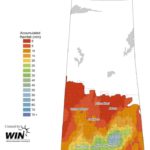(Reuters) – Two days of rainstorms in Saskatchewan, Canada’s biggest wheat- and canola-growing province, may have done more harm to crops than good, even though farms were parched, a Saskatchewan government official said on Wednesday. Much of the province received rain on Monday and Tuesday, with the capital, Regina, collecting about 90 millimetres (3.5 inches), […] Read more

Sask. crops get soaked, but may take yield hit
Above-average wheat yields in southern North Dakota
Hebron, ND (Reuters) — Spring wheat prospects are above average in southern North Dakota, scouts on an annual crop tour said on Tuesday. Crop scouts on the Wheat Quality Council’s tour travelling one route in south-central and southwestern North Dakota made four stops and projected an average yield of 45.6 bushels per acre (bpa), above the […] Read more
CLWG Submission to the CTA
Reading Time: < 1 minute On February 19, 2015, the Honourable Gerry Ritz, Minister of Agriculture and Agri-Food, announced a renewed mandate for the Crop Logistics Working Group (CLWG). The CLWG brings together agriculture sector experts to provide advice on how to improve the grain handling and transportation system. The CLWG is chaired by Mr. Murdoch MacKay, and includes representation […] Read more

CWB tour pegs wheat at 38.9 bushels
Regina / Reuters —Western Canada spring wheat, durum and canola yields look to fall sharply from last year’s levels, due to hot, dry conditions, leaders of a crop tour said on Friday. The second-annual CWB Market Research Services crop tour pegged spring wheat yield potential in the region at 38.9 bushels per acre on average, down […] Read more

Get the facts on wheat midge
Reading Time: < 1 minute Wheat midge is about half the size of a mosquito and bright orange, but is commonly confused with lauxanids, which are a little bigger and yellowish brown. Wheat midge lays eggs in the wheat head and the larvae will then feed on the wheat kernels. One midge for every four to five wheat heads can […] Read more

Keep watch for fusarium graminearum in cereal crops
The fungal disease is established in southern Alberta in areas especially under irrigation
Reading Time: 2 minutes Fusarium graminearum (Fg) is a serious fungal disease, affecting yield and quality. Recent surveys indicate Fg is established in southern Alberta and traces are present in central and northern regions of the province. “When weather conditions are favourable for infection, and in irrigated cropping systems, an in-crop fungicide application may be considered, but only provides […] Read more
Durum faring better in SE Alta: CWB tour
Skiff, Alberta / Reuters — Durum, the wheat used to make pasta, has fared better against dry conditions than other major crops in a pocket of southeastern Alberta, crop tour scouts noted on Wednesday. Durum is typically planted in drier soils than spring wheat, but fields still looked surprisingly decent, given some of the driest […] Read more
Spring wheat yields puny in dry Alberta: CWB tour
Lethbridge/Reuters — Spring wheat yields measured less than half of last year’s results in drought-stricken southeastern Alberta, but were on track to set a record high in southern Manitoba, during a Canadian crop tour that saw the results of wildly contrasting weather. The tour organized by CWB Market Research Services is travelling on three routes […] Read more

Partnership a first for cereal breeding
Alberta Wheat Commission partners with private seed company and feds to develop new Canada Prairie Spring Red wheat breeding
Reading Time: 3 minutes A deal that is the first of its kind in Canada is being hailed as a major boost to Canada Prairie Spring Red wheat breeding — and a model for future cereal-breeding efforts. “From an Albertan perspective, it’s a huge opportunity for us,” said Kent Erickson, chair of the Alberta Wheat Commission “We can take […] Read more
Prairie cash wheat prices down but durum bids up
Average CWRS wheat prices were down by $7 to $12 per tonne over the week
Commodity News Service Canada — Spring wheat cash bids across Western Canada moved lower during the week ended July 17, as losses in the U.S. futures and improving weather conditions in some parts of the Prairies weighed on values. However, durum was the one bright spot from a pricing standpoint, with declining Canadian crop prospects […] Read more

